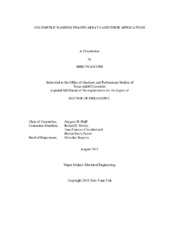| dc.description.abstract | This dissertation mainly focuses on the topics of phased array, volumetric array, random array, circular polarization, beamforming, beamshaping, mobile platform, and all these combinations. The ultimate goal was to realize wireless phased array applications carried out by mobile platforms. To make this idea into reality, there are some challenges we need to overcome. The first one is the wireless phase synchronization, and not only the frequency but also the phases should be synchronized. The second challenge is to know the relative position location and global position orientation of each array element. The last is to develop collaborative beamforming algorithms, which is the major contribution of this dissertation.
There is a total of five projects in this dissertation. The first one constructed a volumetric random array with two types of dissimilar antennas and generated a circular polarized radiation pattern. The goals were to understand how to make diverse antennas work cooperatively and what is the standardized step by step procedures to achieve the best system performance.
The second project generated a circular polarized radiation pattern with each antenna element arbitrarily oriented and distributed randomly within a volume. The purpose of giving each antenna element some freedoms of rotation is to simulate the real mobile platform environment.
The third project developed an amplitude tapering algorithm for the volumetric random array. The reason to apply the amplitude tapering on random array is because the
sidelobe cancellation for a small number of elements is trivial. For this reason, it is necessary to apply amplitude tapering on random array to further reduce the sidelobe level.
The fourth project investigated the reflect beamforming how the incident waves reflect back to the original direction or to a specific direction. Therefore, the project is separated to two parts. Part A is to develop a retrodirective array prototype, which has the same functionality as a reflector based on the Van Atta array structure. Then part B added additional phase shifters to make the prototype become a signal relay system.
The fifth project investigated both the indirect beamforming and amplitude tapering techniques implemented on a metal plate with circular slots. One advantage of this topology is to create a two-hundred-element array radiation pattern by using a single plane wave excitation. Beam scanning by moving the plane wave excitation was also investigated. | en |


